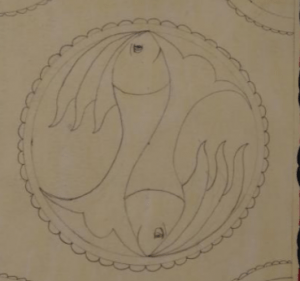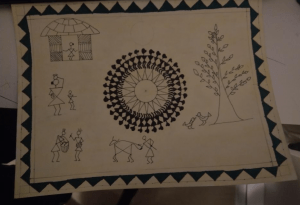Welcome to my 6th blog post about my In-depth project. I am entering the final stages of my project, however I still feel like there is work to be done. I am doing Indian folk art, and my current project is Madhubani art. There are surprisingly quite a few similarities between Madhubani and Warli, the previous art form I was working with. Both have a carefully measured border and center point, and both use a central circle. However, Madhubani relies more on freehand drawing as well, and there isn’t the same radial pattern all around.
We focused more on the main drawing itself. We drew a circle at the center using a protractor.
Last Time, we drew rays coming out of the origin of the circle. This time we just drew a smaller circle inside it.
From there, we drew an S shaped line across the diameter. We drew a curve on both sides of the line to look like fish. Then we drew the tail, fins, etc.
When drawing the face, I had the idea to use eyes from human characters I used to draw. These eyes fit the fish very well and added my own touch to them.
Inside the fish, I drew a pattern of my choice on the body. We will add more design to the negative space left in the circle.
Moving on from the fish, we drew a quarter circle on each corner. We covered the corner circle in flower-like petals. We will add more here.
Center Area:

How Will I Present My In-depth Learning?
I plan on presenting by putting my two drawings side by side on a board. I will have them clearly labelled, and I will also try to find as many progress pictures as I can find to print out. I will stick these pictures onto a board in chronological order, leading down to the last one. I will also print small paragraphs of information on my art forms so people can quickly read them. To make my post more interactive, I can have pictures of small design features and have people guess which drawing they are a part of. Overall, my learning center will showcase what I have hand drawn as well as my gained knowledge on this topic. In the next lesson or so, I have to finish my second drawing and get it ready to present. I have enjoyed this project a lot, and I feel like I’ve grown a lot in understand my culture and background. I hope to continue learning more.




